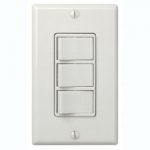RustyShackleford
Senior Member
- Location
- NC
- Occupation
- electrical engineer
Customer wants to use rope lights along the top of a valance, LED ones that aren't dimmable. His clever idea is to use a split duplex outlet to power the rope lights: three strands of rope, 2 connected to one outlet and a third to the other. By turning on one, or the other, or both outlets, three different light levels: just like a three-way table lamp that uses a bulb with one 50-watt element and one 100-watt element. Seems like a lot of trouble, but not really; one rope strand is not bright enough anyhow, and running the split outlets just requires using 14-3 instead of 14-2.
But the switch ... It's easy to find a rotary switch that does the job:
http://www.hubbellcatalog.com/raco/raco_datasheet.asp?PN=6357&FAM=RacoSpecialtySwitche
... but not one designed as a single gang wall switch. I wonder if anyone knows of such a thing ? Or sees an NEC or other problem just mounting the above in a switch plate (since there'd be no yoke connecting the switch to the box) ?
But the switch ... It's easy to find a rotary switch that does the job:
http://www.hubbellcatalog.com/raco/raco_datasheet.asp?PN=6357&FAM=RacoSpecialtySwitche
... but not one designed as a single gang wall switch. I wonder if anyone knows of such a thing ? Or sees an NEC or other problem just mounting the above in a switch plate (since there'd be no yoke connecting the switch to the box) ?

